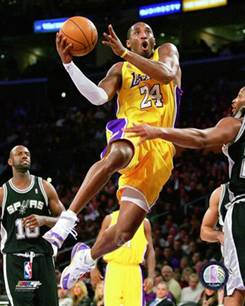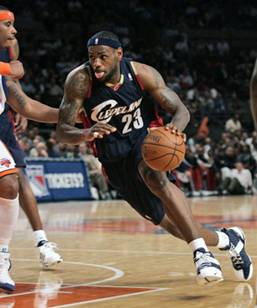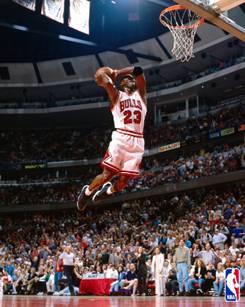|
Of LeBron, Kobe and Jordan:
Masters of the Art By Ira Berkow |
||
|
The dazzling Kobe Bryant. |
The sensational LeBron James. |
Michael Jordan: Out of This
World! |
|
Of LeBron, Kobe and Jordan:
Masters of the Art By Ira Berkow The first time I saw him
play basketball was, in all places, Hackensack, N.J. He was only 16 years
old, going into his junior year at a high school in Akron, Ohio, but, at 6-foot-7,
215 pounds, looked muscular enough to, if need be, lift your car to check
underneath for where the knock was coming from. He played point guard,
shooting guard, small forward – he seemed eminently comfortable anywhere on
the court. A kind of hoops Swiss Army knife. He could slice swiftly to the
basket, he could post up and execute a slam dunk with his back to the basket,
or rain three-point shots from well beyond the arc. And if you were open near
the basket, you’d suddenly find the ball in your hands, softly and sweetly,
gratis LeBron James. This was in July 2001 at
a summer basketball camp on the Fairleigh Dickinson campus for some 200 of
the best high-school basketball players in the country. And he was the best
and mightiest player on the court, a seeming pro among amateurs. There was even
speculation among the NBA scouts attending that he could be a top pick – a
lottery pick – in the draft. A high-school junior? Or would he elect to go to
college? There was a slew of college scouts doing homework there, as well. I had come to see for
myself if the hype for James was merited. And it’s always amusing to try to
put yourself in the position of scouts and try to project. Tom Konchalski, who
evaluates high-school players for his respected High School Basketball
Illustrated Report, said, “LeBron isn’t an extraterrestrial athlete, but he
has a tremendous feel for the game. He sees situations two passes ahead of
the play. He’s been compared to Vince Carter and Tracy McGrady.” Two
outstanding pros then in their virtual prime. “But I think he has a better
feel for the game than they do.” He meant,
surely, that LeBron had a better feel for the game than when they were
his age. “No, I mean right now.” I wasn’t so sure.
Looking back, I was wrong. It’s an interesting and
sometimes thankless task to make projections of players, though scouts and
general managers must do it all the time. How do you evaluate beyond talent –
to drive and heart? Even, how do you evaluate and predict the levels that talent can or cannot
achieve? Well, the James story has essentially been written as far as those questions are concerned. He was the No. 1 pick, by the Cleveland Cavaliers, in the 2003 NBA draft, following his high-school graduation, and signed a $90 million shoe contract with Nike before his pro debut. He has since become probably one of the two best players in the NBA. His team lost in the playoff semifinals last
season but are a favorite to make the finals this season, against the Lakers
and their high-wattage star, Kobe Bryant. Bryant, like James, was
considered the best high-school player in the country, and, like James, I
wanted to see for myself. It was in Ambler, Pa., in a playoff game in the
Pennsylvania state tournament, in February 1996. Bryant was a 6-foot-6,
17-year-old senior playing for Lower Merion who, unlike James, was slender as
a mop handle. He played the same
positions that James did – though, like James, not all at the same time, though
it might seem that way. In a playoff game the week before Bryant had scored
50 points. Against Norristown High,
Bryant was the center of attention not only of the spectators in the
overflowing stands, but of the opposition as well. If he didn’t know what a
cocoon felt like before, he did now. Two, three and sometimes four Norristown
players gathered around him as if he were a kindly uncle dispensing dollar
bills to his nephews. And while Bryant scored
21 points – including 10 of 11 free throws – but made only 5 of 23 from the
floor, he was still able to hit his teammates with pinpoint passes, and Lower
Merion won, and advanced in the tournament. One of the scouts at his
game was Hal Wissel of the New Jersey Nets. “The thing the scouts like so
much about him, besides his talent, is his mentality,” said Wissel. “He’s a
very confident, very centered young man. And I guess you have to credit his
dad, and his family environment, for a lot of that.” Bryant’s father is Joe
(Jelly Bean) Bryant, a former NBA player and at the time an assistant coach
at LaSalle College in Philadelphia. In the locker room after
the game, Bryant’s attitude was upbeat. “Yes, I would like to have shot
better, but my dad always told me to be an all-around player,” said Bryant.
“And if I can’t be on in shooting, then I can rebound, set up the other guys
with passes and play defense. And I think I did that.” Off that game, however,
he didn’t impress me as much as James would. In evaluating a player, it’s
essential, obviously, to see him more than once. Apparently Jerry West, then
the general manager of the Lakers, did. Rick Pitino, then the
coach of the University of Kentucky, told this story about playing golf with
West. Pitino said, “I think we have a good chance of getting Kobe Bryant.”
West said, “He’s going straight to the pros.” Pitino said, “He is?” West
replied, “I’m sure of it. I think we can get him, and he’s going to be one of
the best players in the history of basketball.” Pitino said, “You mean, he’s
going to be a very good player.” West: “No, one of the best ever.” West obviously saw more
in Bryant that either Pitino or I did. And he was right. Bryant was picked 13th
overall in the NBA draft by Charlotte, and in a previously arranged deal West
immediately traded for him. Bryant was soon an all-star. Michael Jordan, who
knows something about basketball – but not everything, was the director of
player personnel of the Washington Wizards and selected another high-school
player in the NBA draft of 2001, Kwame Brown, a 6-11, 250-pound, 19-year-old
center-forward from Brunswick, Georgia, a town of 14,000. Brown became the first high-school player
ever selected first overall. Jordan had played Brown one-on-one and was
impressed. I was, too. Shortly after the draft, I took Brown for lunch to a
French restaurant – his first – Brasserie Jo, in Boston, where he was playing
in a pro summer league. He perused the menu. “What’s steak tartare?”
he asked the waiter. “It’s very good,” said
the waiter. I added, trying to be helpful, “It’s uncooked.” “I don’t eat raw
anything,” Brown said. “It’ll kill you.” “Something to start?”
the waiter asked, moving on. “House salad,” Brown
said, “with French dressing.” “I know it’s odd, this being
a French restaurant,” said the waiter, “but we don’t serve French dressing.” “No French dressing?”
Brown repeated. “Bennie’s Red Barn has the best French dressing.
Unbelievable.” “Bennie’s Red Barn?” I
said. The waiter’s eyes widened. “It’s
the best restaurant in the Brunswick area,” Brown said. “You’ve got to go
there sometime. And the steaks. They’ve got this T-bone, it’s this thick, and
it’s bigger than this plate. I like mine medium rare, well, just this side of
burnt.” The rest of the meal was
about as eventful, and that night I saw Brown play. It appeared that he had a
lot of potential, but was hardly polished. In my evaluation, however, I
thought he was going to be a big star, a real force in the paint. Also, from
the lunch, I thought he really knew what he wanted, and how to get it. Little
things may often tell a lot, or so I imagined. Well, after a time,
Jordan became disenchanted with Kwame, and his work ethic. Brown was traded to the Lakers, who traded
him to the Memphis Grizzlies. He currently rides the bench for the Detroit
Pistons, an eight-year journeyman pro. Oh, you may be wondering
what Brown ordered for an entrée at our lunch. It was the Parisian steak
frites. “What’s that on there?”
Brown asked, when the waiter placed the dish in front of him. “Garlic butter,” the
waiter explained. Brown stared at the
yellow substance puddle on his meat. The waiter, well, waited. Perhaps he
wondered if it was anything like the steak at Bennie’s Red Barn. After
a moment, Kwame cleared his throat and looked up. “Have you any A-1 sauce?”
he asked politely. Pulitzer Prize-winning
sportswriter Ira Berkow’s most recent book, “Summers in the Bronx: Atilla the
Hun and other Yankee Stories,” was published by Triumph Books (December
2009). |
||


